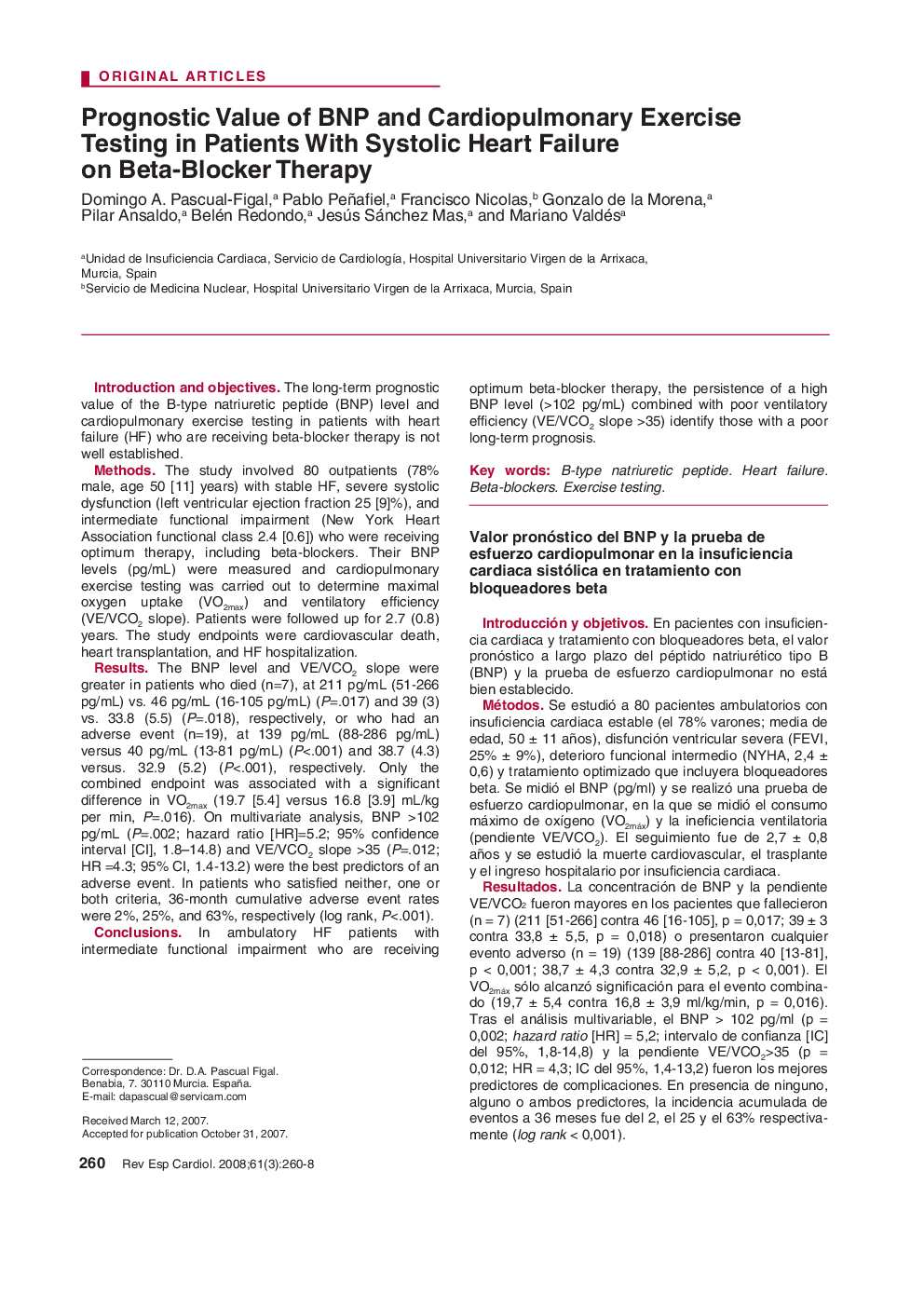| Article ID | Journal | Published Year | Pages | File Type |
|---|---|---|---|---|
| 3018906 | Revista Española de Cardiología (English Edition) | 2008 | 9 Pages |
Introduction and objectivesThe long-term prognostic value of the B-type natriuretic peptide (BNP) level and cardiopulmonary exercise testing in patients with heart failure (HF) who are receiving beta-blocker therapy is not well established.MethodsThe study involved 80 outpatients (78% male, age 50 [11] years) with stable HF, severe systolic dysfunction (left ventricular ejection fraction 25 [9]%), and intermediate functional impairment (New York Heart Association functional class 2.4 [0.6]) who were receiving optimum therapy, including beta-blockers. Their BNP levels (pg/mL) were measured and cardiopulmonary exercise testing was carried out to determine maximal oxygen uptake (V02rnax) and ventilatory efficiency (VE/VC02 slope). Patients were followed up for 2.7 (0.8) years. The study endpoints were cardiovascular death, heart transplantation, and HF hospitalization.ResultsThe BNP level and VE/VC02 slope were greater in patients who died (n=7), at 211 pg/mL (51-266 pg/mL) vs. 46 pg/mL (16-105 pg/mL) (P=.017) and 39 (3) vs. 33.8 (5.5) (P=.018), respectively, or who had an adverse event (n=19), at 139 pg/mL (88-286 pg/mL) versus 40 pg/mL (13-81 pg/mL) (P<.001) and 38.7 (4.3) versus. 32.9 (5.2) (P<.001), respectively. Only the combined endpoint was associated with a significant difference in V02rnax (19.7 [5.4] versus 16.8 [3.9] mL/kg per min, P=.016). On multivariate analysis, BNP >102 pg/mL (P=.002; hazard ratio [HR]=5.2; 95% confidence interval [Cl], 1.8-14.8) and VE/VC02 slope >35 (P=.012; HR =4.3; 95% Cl, 1.4-13.2) were the best predictors of an adverse event. In patients who satisfied neither, one or both criteria, 36-month cumulative adverse event rates were 2%, 25%, and 63%, respectively (log rank, P<.001).ConclusionesIn ambulatory HF patients with intermediate functional impairment who are receiving optimum beta-blocker therapy, the persistence of a high BNP level (>102 pg/mL) combined with poor ventilatory efficiency (VE/VC02 slope >35) identify those with a poor long-term prognosis.
Introducción y objetivosEn pacientes con insuficiencia cardiaca y tratamiento con bloqueadores beta, el valor pronóstico a largo plazo del péptido natriurético tipo B (BNP) y la prueba de esfuerzo cardiopulmonar no está bien establecido.MétodosSe estudió a 80 pacientes ambulatorios con insuficiencia cardiaca estable (el 78% varones; media de edad, 50 ± 11 años), disfunción ventricular severa (FEVI, 25% ± 9%), deterioro funcional intermedio (NYHA, 2,4 ± 0,6) y tratamiento optimizado que incluyera bloqueadores beta. Se midió el BNP (pg/ml) y se realizó una prueba de esfuerzo cardiopulmonar, en la que se midió el consumo máximo de oxígeno (VO2máx) y la ineficiencia ventilatoria (pendiente VE/VC02). El seguimiento fue de 2,7 ± 0,8 anos y se estudió la muerte cardiovascular, el trasplante y el ingreso hospitalario por insuficiencia cardiaca.ResultadosLa concentración de BNP y la pendiente VE/VCO2 fueron mayores en los pacientes que fallecieron (n = 7) (211 [51 − 266] contra 46 [16–105], p = 0,017; 39 ± 3 contra 33,8 ± 5,5, p = 0,018) 0 presentaron cualquier evento adverso (n = 19) (139 [88–286] contra 40 [13–81], p < 0,001; 38,7 ± 4,3 contra 32,9 ± 5,2, p < 0,001). El VO2máx sólo alcanzo significacion para el evento combinado (19,7 ± 5,4 contra 16,8 ± 3,9 ml/kg/min, p = 0,016). Tras el análisis multivariable, el BNP > 102 pg/ml (p = 0,002; hazard ratio [HR] = 5,2; intervalo de confianza [IC] del 95%, 1,8–14,8) y la pendiente VE/VC02>35 (p = 0,012; HR = 4,3; IC del 95%, 1,4–13,2) fueron los mejores predictores de complicaciones. En presencia de ninguno, alguno 0 ambos predictores, la incidencia acumulada de eventos a 36 meses fue del 2, el 25 y el 63% respectivamente (log rank< 0,001).ConclusionesEn pacientes con insuficiencia cardiaca, deterioro funcional intermedio y tratamiento optimizado con bloqueadores beta, la persistencia de un BNP elevado (> 102 pg/ml) y la ineficiencia ventilatoria (pendiente VE/VC02 > 35) identifican a los pacientes con peor pronostico a largo plazo.
